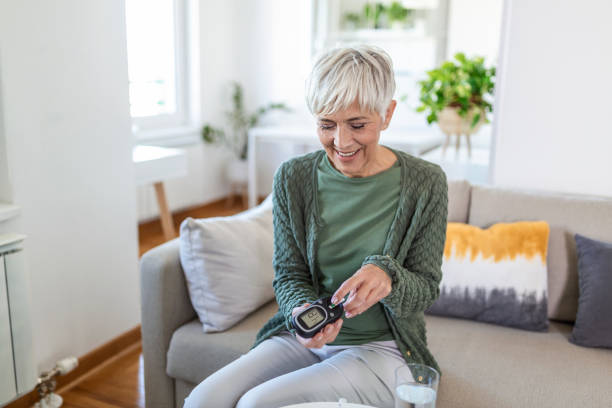For people with diabetes, regularly monitoring blood glucose levels is critical for managing their condition and avoiding complications. Remote blood glucose monitoring technologies allow patients to share glucose data with their healthcare providers easily. This supports better disease management and outcomes.
The following article outlines the evidence-based benefits of remote blood glucose monitoring and how it supports diabetic patients throughout their lifespans. We also cover what chronic care companies want to look for when choosing an FDA-cleared blood glucose meter device.
Remote Blood Glucose Monitoring for Diabetes Management
With remote blood glucose monitoring, patients use Bluetooth or cellular blood glucose meters to send readings to physician portals and monitoring platforms automatically. By automating the process, remote patient monitoring reduces human error caused by manual tracking and reporting. Access to wireless glucose meters makes it easier for diabetic patients to monitor their chronic condition from anywhere.
The data helps patients identify trends and see how diet, exercise, stress, and medication affect their blood sugar. By spotting these patterns, patients can better regulate their glucose levels through lifestyle adjustments and treatment plans tailored to their needs.
Overall, remote blood glucose monitoring empowers patients with data-driven insights to manage diabetes proactively. It also gives providers valuable information to deliver more personalized, effective care. Healthcare organizations should look for FDA-cleared solutions that seamlessly and securely share glucose data between patients and providers when implementing remote monitoring.
Remote Patient Monitoring: Reducing Barriers to Healthcare
Barriers to quality medical care threaten the health of underserved populations, especially those with diabetes. Additional social determinants, such as social and economic factors, can impact people’s health and quality of life. Remote patient monitoring (RPM) helps reduce barriers to care because physicians can monitor patients’ health regardless of where they live.
Researchers in one study found that remote patient monitoring for the management of diabetes mellitus in pregnancy is superior to a traditional paper-based approach in achieving glycemic control and is associated with improved maternal and neonatal outcomes.
Pregnancy Remote Blood Glucose Monitoring
Prenatal care requires frequent visits with a healthcare provider. These visits are critical for risk assessment, education, and patient-provider relationships. Some women who develop gestational diabetes mellitus need high-risk pregnancy care, as complications can arise during pregnancy and childbirth. However, many pregnant women face barriers due to quality healthcare.
With remote blood glucose monitoring, pregnant patients have access to the vital tools needed to monitor their health and the health of their newborn. Remote pregnancy monitoring also benefits patients by creating an ongoing relationship with a healthcare provider to keep them and their children healthy. A 2023 study of remote glucose monitoring for managing diabetes during pregnancy showed that RPM is superior to a traditional paper-based approach in achieving glycemic control. Results also showed that RPM is associated with improved maternal and neonatal outcomes.
Pediatric Remote Blood Glucose Monitoring
A pediatric diagnosis of type 1 diabetes requires frequent interaction between patients, caregivers, and providers to review blood glucose trends and adjust medication as needed. Traditionally, meetings occur via telephone to check patient measurements. Remote patient monitoring for diabetes care has alleviated the need for manually recording and communicating that data to healthcare providers between office visits.
A pilot study at UC Davis Health Pediatric Diabetes Clinic of remote patient monitoring in 39 pediatric patients with type 1 diabetes found remote patient monitoring was highly feasible. 94% of participants reported remote patient monitoring was helpful. In addition, researchers found RPM may be particularly beneficial for patients with suboptimal glycemic control at entry. Interestingly, clinician efficiency also improved by using remote monitoring instead of traditional care.
Type 1 & 2 Diabetes Remote Blood Glucose Monitoring
It is important to note that remote patient monitoring is not a substitute for in-office appointments. Diabetic patients generally meet with their physician every 3-6 months. RPM focuses on transmitting daily data to physicians for better healthcare between visits to ensure that complications are not progressing. Engaging diabetic patients in regular blood glucose monitoring is crucial as patients become more informed and involved in managing their diabetes.
Likewise, access to real-time, accurate blood glucose data allows clinicians to manage patients’ treatment plans to improve outcomes efficiently. A 2023 study found that using a Bluetooth-connected blood glucose meter and a mobile diabetes app improved glycemic control in range and reduced hyperglycemia in over 144,000 people with type 1 or type 2 diabetes.
Choosing an RPM Blood Glucose Meter
With the many blood glucose meter options available today, selecting the best glucose monitor for specific patient populations can be challenging. First, choosing an RPM glucometer that provides accurate measurements is vital. Clinical teams continually monitor patient glucose levels and want the most accurate results. Additional essential factors for device consideration include:
- FDA clearance: This refers to the FDA allowing a device to market through the 510(k) process.
- Consistent performance: Results must be reliable and valid for each reading.
- Accessibility: The ability to preset thresholds to notify physicians of concerning readings.
- Connectivity: BGM meters that do not require setup make it easy for patients and cut down on technical support inquiries.
- Portability: Patients appreciate portable meters, and carrying cases are helpful for patients to use on the go.
- Durability: A meter that performs reliably after repeated use is vital.
- Overall ease of use: Meters that make taking blood sugar easy for all populations lead to less frustration for users.
- Overall affordability: Glucose meters vary considerably in terms of pricing.
Tenovi works exclusively with companies that would like to offer remote patient monitoring solutions to healthcare providers. Are your partners interested in a better remote blood glucose monitoring experience? Visit tenovi.com to learn more about our no sync, no app RPM hardware and software services.






